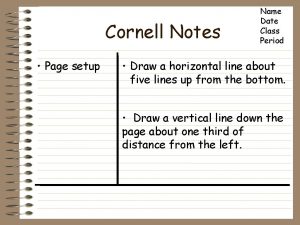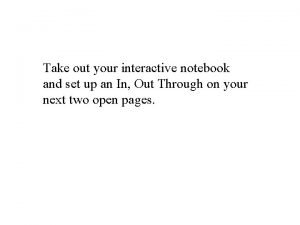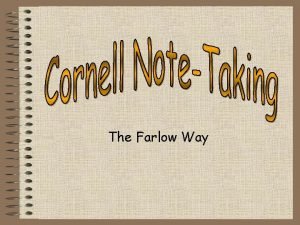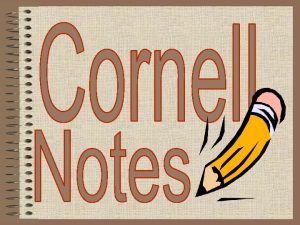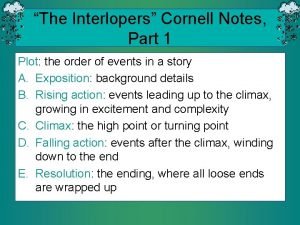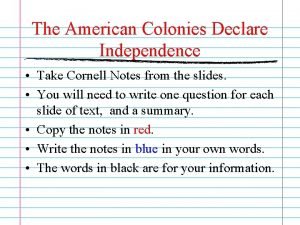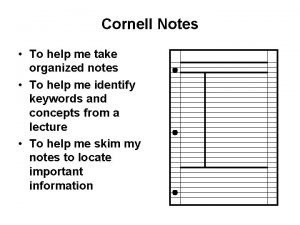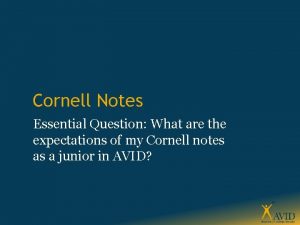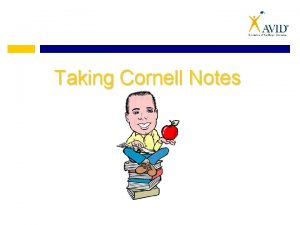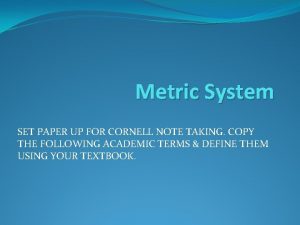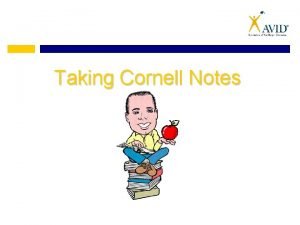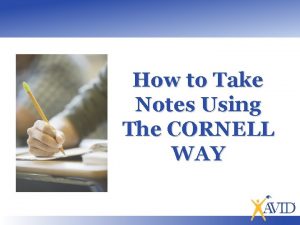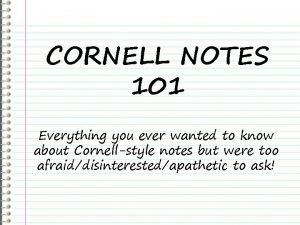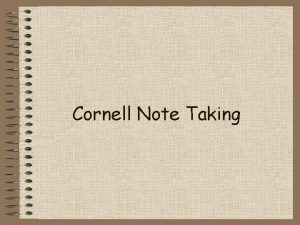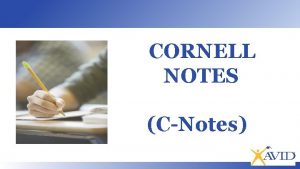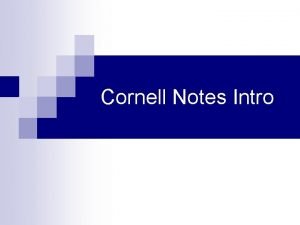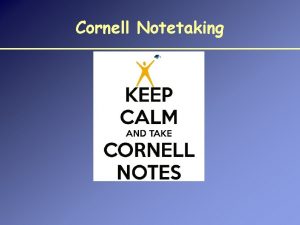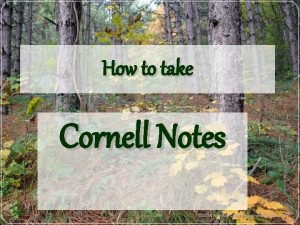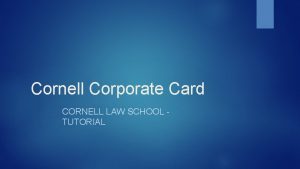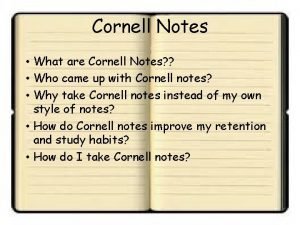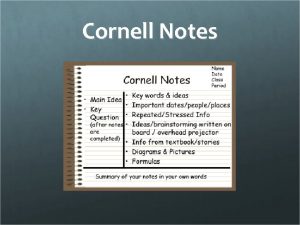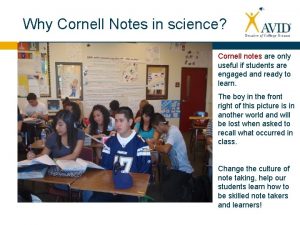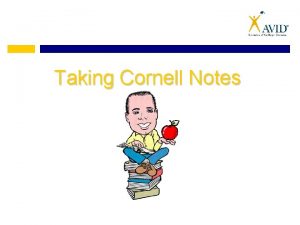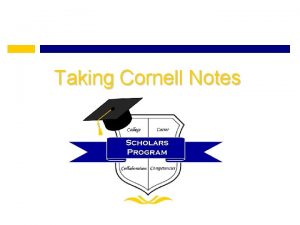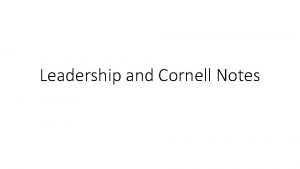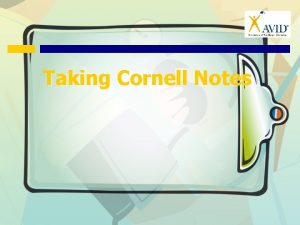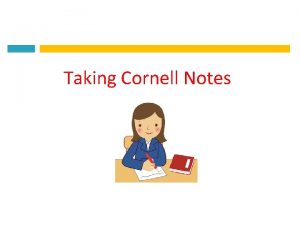CORNELL NOTES CNotes What are Cornell Notes The


















- Slides: 18

CORNELL NOTES (C-Notes)

What are Cornell Notes? The Cornell method of note taking provides a systematic format for condensing and organizing notes. The student divides the paper into two columns: the note-taking column and question column. Within 24 hours of taking the notes, the student must revise and write questions (on the left) and then write a brief summary at the bottom of the page. When studying for either a test or quiz, the student has a concise but detailed and relevant record of previous classes. When reviewing the material, the student can cover the note-taking (right) column while attempting to answer the questions/keywords in the key word or cue (left) column. The student is encouraged to reflect on the material and review the notes regularly.

https: //www. youtube. com/watch? v =c 4 Nh 4 b. SFvr. I

Essential Question CORNELL NOTES TOPIC/OBJECTIVE: NAME: CLASS/PERIOD: DATE: ESSENTIAL QUESTION: How does using the CORNELL WAY support the processing and retention of important material?

Focused Note-Taking CORNELL NOTE-TAKING SYSTEM NOTE-TAKING NOTE-MAKING STEP 1 Create Format STEP 3 Review & Revise Notes STEP 2 Organize Notes STEP 4 Note Key Ideas to Create Questions STEP 5 Exchange Ideas by Collaboration NOTEINTERACTING STEP 6 Link Learning to Create a Synthesized STEP 7 Summary Use Completed Cornell Notes as a Learning Tool NOTEREFLECTING STEP 8 Written Feedback STEP 9 Address Written Feedback STEP 10 Your Reflection

Steps 1 -2 (Note-Taking) • C-Create format and heading, including Essential Question • O-Organize notes on the right hand side of the paper while taking notes during lecture

Steps 3 -5 (Note-Making) • R-Review and Revise notes • N-Note Key Ideas (create questions on the left side of the paper that connect to main ideas on the right) • E-Exchange ideas and help each other fill in gaps

Steps 6 -7 (Note-Interacting) • L-Link Learning by summarizing notes at the bottom of the paper • L-Use notes as a Learning Tool by reviewing what was learned

Step 8 (Note-Reflecting) • W - Using the resources and rubrics on My. AVID, give Written Feedback on each other’s notes

Step 9 (Note-Reflecting) • A – Address feedback by: • Reviewing partner’s feedback. • Addressing the feedback by creating a goal on how to improve notetaking skills.

Step 10 (Note-Reflecting) • Y - Reflect on Your overall learning by reviewing all of the notes taken over a topic.

“Before” & “After” The CORNELL WAY

Review – The CORNELL WAY Create format Organize your notes Review and reflect Note key ideas Exchange key ideas Link learning Learning tool Written feedback Note-Taking Note-Making Note-Interacting Note-Reflecting

Review: Note-Taking Create your Cornell note paper. Write in the Essential Question. Use preferred style and organization.

Review: Note-Making ● Underline key information in the notes. ● Fill in gaps with a partner. ● Look for “chunks” of notes. ● Write corresponding questions.

Review: Note-Interacting Answer each question you’ve written to compose a summary. Use the completed notes as a learning tool (e. g. foldover method).

Review: Note-Reflecting Address the feedback on your notes from the teacher or a peer. Reflect on how your notes have prepared you for tests.

Essential Question CORNELL NOTES TOPIC/OBJECTIVE: NAME: CLASS/PERIOD: DATE: ESSENTIAL QUESTION: How does using the CORNELL WAY support the processing and retention of important material?
 Mikael ferm
Mikael ferm Cornell notes setup
Cornell notes setup Ions and ionic bonding cornell doodle notes
Ions and ionic bonding cornell doodle notes Cornell notes setup
Cornell notes setup How to set up cornell notes
How to set up cornell notes The interlopers summary
The interlopers summary Declaration of independence cornell notes
Declaration of independence cornell notes Science cornell notes
Science cornell notes How does cornell notes work
How does cornell notes work What is the essential question in cornell notes
What is the essential question in cornell notes Cornell notes setup
Cornell notes setup Walter pauk cornell notes
Walter pauk cornell notes What does cornell notes look like
What does cornell notes look like Metric system cornell notes
Metric system cornell notes Cornell notes for anatomy and physiology
Cornell notes for anatomy and physiology What do cornell notes look like
What do cornell notes look like Cornell way
Cornell way Cornell notes advantages
Cornell notes advantages Cornell notes setup
Cornell notes setup

